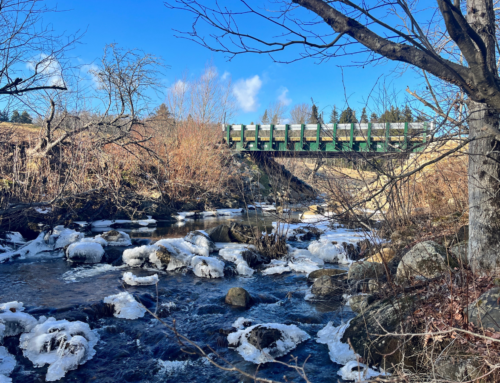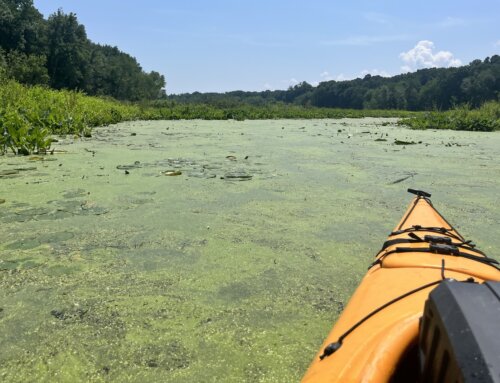Vermont, June 1, 2013. As the 2013 river season beckons, the Connecticut River Watershed Council asks all river users to help protect the Connecticut River and its tributaries from invasions of exotic plants and animals. Whether you use a powerboat, row, canoe, kayak, wade, fish or sail, river enthusiasts have a special responsibility to protect the Connecticut River watershed. Being responsible is not a difficult task just think: Check, Clean or Dry!
When exotics establish themselves in a new habitat they propagate more quickly than native species. They do not face their usual predators or our native species are not resistant to new viruses. In their uncontrolled explosions, exotics deny native species their usual habitat. They also create problems for humans; just ask anyone living on a lake where Eurasian milfoil has taken hold and choked their lake or ask someone responsible for keeping a water intake pipe open in the presence of zebra mussels.
A potential invasion of a virulent infectious virus Viral Hemorrhagic Septicemia, called VHS discovered is just some 75 miles to the west of our watershed. VHS has the potential to kill fish by the thousands. Moving fish from one water body to another risks spreading the virus. Heed the restrictions on moving untested uncertified baitfish between water bodies including those you net yourself. Beyond the virus know where your bait came from, what the species is and whether or not it is a native to the body of water where you are fishing. The introduction of the wrong species of baitfish into a water body can have devastating effects on the resident fish.
Seven years ago the invasive algae Didymosphenia geminata, better known as didymo or rock snot was discovered in the Connecticut River just below the Connecticut Lakes. It has since been found in the White River, the Mad River and the Battenkill. Didymo has the potential to destroy river bottom habitat and make our watershed rather unappetizing to fish or swim in. Fishing waders are just one way of transporting this invasive, so are PFDs, wet suits, sneakers and bathing suits. Soak all items capable of absorbing water in hot soapy water for 20 minutes or completely dry them out before going into new waters.
Recently zebra mussels were discover in Massachusetts just one lake outside the Connecticut River watershed. The response was swift; the boat ramp was closed, as were boat ramps within easy driving distance of the contaminated lake and at the Quabbin Reservoir. Even with that quick response, the odds are great that the mussel will get into the Connecticut River watershed. Boaters in MA must now certify on a signed form that their boat has either not been in any water body with zebra mussels or that they have cleaned the boat with hot water and Lysol, bleach or vinegar.
The brief discussion today does not even address the other increasing number of aquatic invasive species including Phragmites, water chestnut, Chinese mystery snail, rusty crayfish, curly leaf pondweed, carp, or the freshwater jellyfish.
There are no “fixes” once exotics are in our waters. Care in preventing further spread of these infestations is the only tool we have at our disposal. Act as though every place you get wet harbors problem species. It does not matter if the waterbody actually harbors exotics; rely on the precautionary principle, be safe not sorry.
What should river users be doing to protect the river? Think: Check, Clean or Dry!
Check: At the ramp during trailering, thoroughly inspect your boat’s hull, drive unit, trim plates, trolling plates, prop guards, transducers, anchor and anchor rope, and trailer. Inspect all craft, powerboat or canoe and scrape off and throw out any suspected mussels and all waterweeds hanging from boat or trailer. Do not move live bait from one water body to another. Do not dump live bait into the water; the bait may be a non-native species or diseased.
Clean: Before launching your boat, thoroughly flush the hull, drive unit, live wells, any pumping system, bilge, trailer, bait buckets, engine cooling water system, and other boat parts that got wet while in any other waters. Drain all bilge water, live wells; bait buckets and any other water from your boat and equipment at the ramp as you leave a water body. One quick way to clean the exterior is to use a hot hard spray from a do-it-yourself carwash. Hot water pumped through an engine’s intake periodically is one method of preventing zebra mussel growth inside an engine’s cooling system. Do not use chlorine bleach or other environmentally damaging washing solutions next to the shore.
Dry: Dry out all items that can absorb or hold water. If you cannot clean your water toys or tools, boats and trailers, PFDs, water shoes and boots, etc. dry them thoroughly in the sun for up to 5 days before using them in another water body.
CRC hopes all of those who play on the river or its tributaries will be especially careful and protect our river from further invasions by exotics. You enjoy it, so protect it and remember: Check, Clean or Dry!
# # #
David L. Deen is the River Steward for the Connecticut River Watershed Council. CRC is celebrating 60 years as a protector of the Connecticut River.







